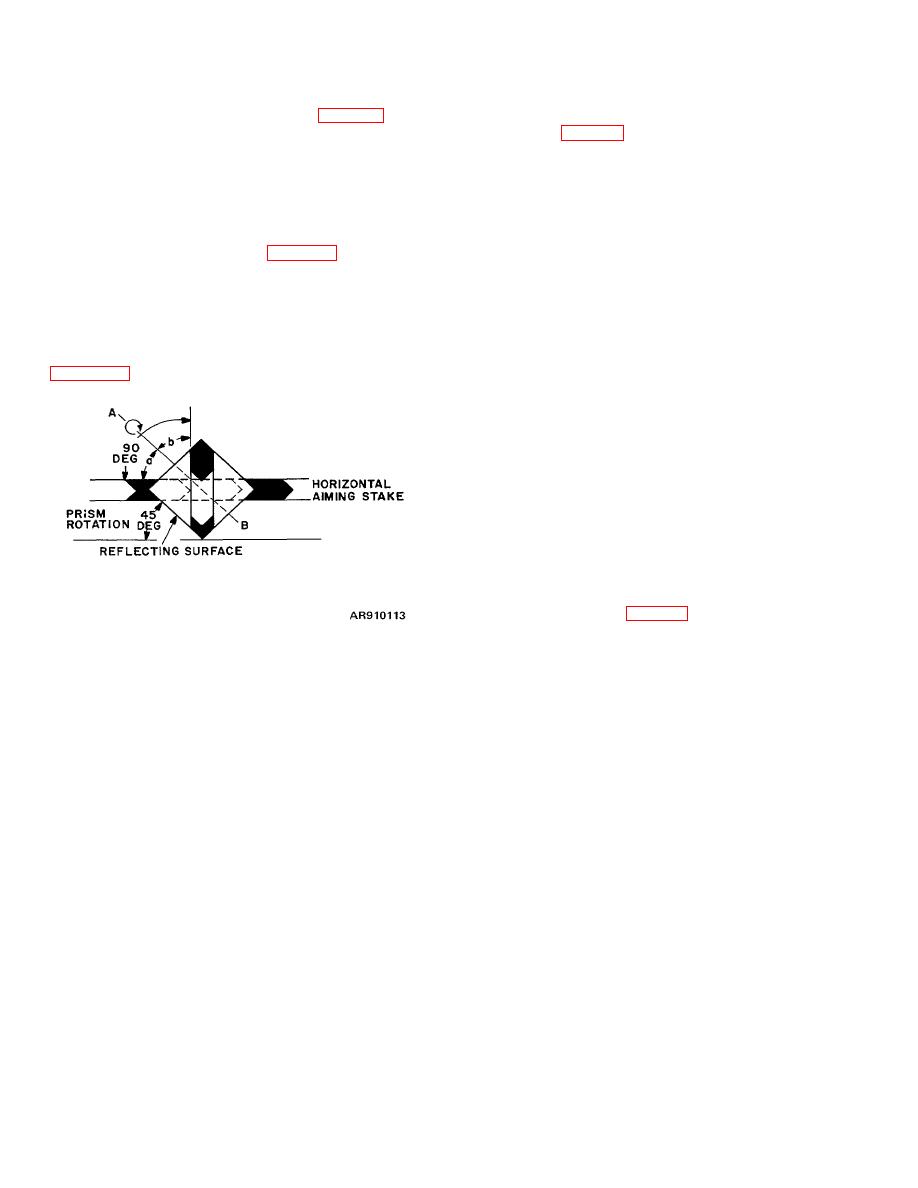 |
|||
|
|
|||
|
|
|||
| ||||||||||
|
|
 TM 9-258
(4) Dove rotating prism.
aiming stake viewed through a horizontal Dove prism
positioned with the reflecting face at 45ƒ angle to the
(a) The Dove rotating prism (A, fig 4-13) is the
means by which the image in some panoramic
horizontal (fig 4-23). Since the image is reverted in the
telescopes is caused to remain erect as the head of the
plane of reflection, it can be considered to revolve about
instrument is rotated. It usually is placed either outside
the axis AB, which is parallel to the reflecting surface. In
this case, angle "a" is 45ƒ; therefore, angle "b" is 45 and
the telescope system proper or between symmetrical
their sum is 90ƒ or twice the angular rotation of the prism
erectors. The line of sight of the rotating head can be
revolved in azimuth 360ƒ (a complete circle) while the
itself. When the 90ƒ prism (in the panoramic head) is
turned 180ƒ, it will transmit an upright but horizontally-
eyepiece is fixed so that the observer does not move.
Some panoramic telescopes (fig 8-16) employ the
reverted image to the Dove prism. Because the field is
objective 90ƒ prism in the head, and the Dove (rotating)
behind the observer, the effect is the same as in viewing
prism is caused to revolve in the same direction and
the user in a mirror where the user's image appears
through one-half the arc of the 90ƒ prism in the head.
reverted horizontally. In order to provide a normal
The field, inverted by the objective 90ƒ prism, and again
image, the Dove prism is so positioned by the 90ƒ
inverted by the Dove prism, also is rotated through twice
rotation of the plane of reflection that horizontal reversion
the arc of travel of the Dove prism itself as illustrated in
occurs.
(d) As both incident and emergent rays are
refracted by a Dove prism, it must be fed by parallel light,
otherwise an aberration is introduced. For this reason it
is usually placed outside (in front of) the telescope
system proper. If it is desired to place a rotating prism
within a telescope system where rays are not parallel, the
Pechan prism is used as its incident and emergent faces
are perpendicular to its surfaces and it is, therefore, not a
refracting prism and will not cause aberrations. If it is
desired to introduce a Dove prism within a telescopic
system, it must be placed between erectors so
positioned that principal rays between erectors are
parallel.
(5) Pechan or Z rotating prism. The Pechan or
Z rotating prism (B, fig 4-13) can be used, similar to a
Dove rotating prism, as a rotating prism in panoramic
telescopes to maintain an erect field by neutralizing the
Figure 4-23. Image rotation in Dove prism (end view).
reverting effect of the objective prism and when the
rotating head is turned ( (4) above). When this prism is
(b) An object such as a vertical aiming stake
rotated about its axis, the image rotates in the same
will appear upside down when viewed through a Dove
directions with double angular speed. By rotating the
prism positioned with its long face horizontal. When
prism, erection of the image is accomplished.
looking forward through the panoramic telescope this
4-8. Mirrors. The mirrors used to reflect the paths of
inversion corrects that initially introduced by the 90ƒ
light in fire-control instruments are not the common
prism in the head. As the panoramic head prism is
household type made of plate glass. The reflecting
revolved from this forward looking position, it introduces
surfaces on household mirrors produce a faint reflection
angular tilt equal to its angular rotation so that when it is
from the front glass surface in addition to that produced
turned to look to the user's left (for example) a vertical
by the silvered back. To eliminate this "ghost image," the
aiming stake will become horizontal in the image. Since
reflecting surfaces of optical mirrors are placed on their
the rotation, or tilt, of the field image produced by rotation
front faces. Mirrors of this type are termed front surface
of the Dove prism is twice the rotation of the plane of the
mirrors. The reflecting surface is a thin film of metal
reflecting surface (in accord with the law of reflection),
chosen for its resistance to tarnish. Such mirrors must
this 90ƒ tilt will be eliminated by a 45ƒ rotation of the
be handled carefully as they can easily be scratched and
Dove prism.
become useless until they can be resilvered or
(c) As an example, consider a horizontal
realuminized.
4-25
|
|
Privacy Statement - Press Release - Copyright Information. - Contact Us |